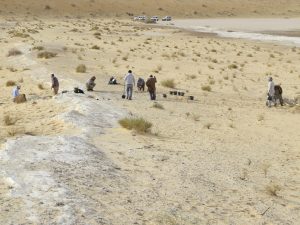Griffith University played a key role in the team behind new research published today inNature Ecology and Evolutionthat describes the discovery of a fossil human finger bone at the site of Al Wusta, an ancient freshwater lake located in what is now the hyper-arid Nefud Desert, in Saudi Arabia.
The fossil has been directly dated to approximately 90,000 years ago, which makes it among the oldest modern human remains found outside Africa and the Levant.
The work, led by Dr Huw Groucutt the University of Oxford and the Max Planck Institute for the Science of Human History, involved an international team from Saudi Arabia, including the Saudi Commission for Tourism and National Heritage and the Saudi Geological Survey, the United Kingdom, Germany, Spain and Australia. Professor Rainer Grün and Drs Julien Louys and Mathieu Duval of the Australian Research Centre for Human Evolution (ARCHE) at Griffith University were key participants in this international effort.

Archaeological surveys and excavations at Al Wusta led to the discovery of numerous animal fossils, including hippopotamus and tiny freshwater snails, associated with abundant lithic tools made by humans.
Among these finds was a well preserved and small fossil human finger bone (AW-1). Further analyses performed in the laboratory showed that the fossil could only come from our species,Homo sapiens.
Using a technique called uranium series dating, this fossil was found to be 90,000 years old, making it the oldest human found in Arabia. The use of other dating methods applied to the sediment and fossil animal teeth were used to confirm this date.
In-depth environmental analyses revealed the site was once a freshwater lake in an ancient grassland environment far removed from today’s desert conditions.
This new discovery is challenging existing notions of modern human dispersal out of Africa, which was thought to have only occurred approximately 60,000 years ago based on genetic data.
However, the Al Wusta finger bone’s age is consistent with other recent discoveries that ARCHE played a role in, including those reported at Misliya (Israel), Lida Ajer (Western Sumatra), and Madjedbebe (Australia), which indicate that the migration and dispersal of Homo sapiens out of Africa happened much earlier than has been previously accepted.
Funding:Aspects of this work have been funded by the Australian Research Council (ARC) Future Fellowships FT160100450 (CI: Julien Louys) and FT150100215 (CI: Mathieu Duval), the ARC Discovery Project DP110101415 (CI: Rainer Grün) and the European Union Marie Curie International Outgoing Fellowship PIOF-GA-2013-626474 (CI: Mathieu Duval).
Reference
Groucutt, H.S., Rainer Grün, Iyad S.A. Zalmout, Nick A. Drake, Simon J. Armitage, Ian Candy, Richard Clark-Wilson, Julien Louys, Paul S. Breeze, M. Duval, Laura T. Buck, Tracy L. Kivell, Emma Pomeroy, Nicholas B. Stephens, Jay T. Stock, Mathew Stewart, Gilbert J. Price, Leslie Kinsley, Wing Wai Sung, Abdullah Alsharekh, Abdulaziz Al-Omari, Muhammad Zahir, Abdullah M. Memesh, Ammar J. Abdulshakoor, Abdu M. Al-Masari, Ahmed A. Bahameem, Khaled S.M. Al Murayyi, Badr Zahrani, Eleanor M.L. Scerri & Michael D. Petraglia. Homo sapiens in Arabia by 85,000 years ago. Nature Ecology & Evolution. DOI: 10.1038/s41559-018-0518-2.
About ARCHE:
The Australian Research Centre for Human Evolution, based in Griffith’s Environmental Futures Research Institute, is the first academic centre specifically focused on gaining a deeper understanding of the scale of ancient human migrations and the full story of the origins of the people in our region. An initiative of Queensland’s Griffith University, ARCHE’s mission is to foster research excellence through multidisciplinary projects that bring together leading Australian and international scholars and institutions in the field of human evolution, with a particular focus on two key regions: Australia and neighbouring Asia.
ARCHE has played a key role in some of the most important recent discoveries associated to the origin of our species, Homo sapiens, with the recent publications on Jebel Irhoud (Morocco), Misliya cave (Israel), Lida Ajer cave (Western Sumatra), Madjedbebe (Australia) and now, Al Wusta (Saudi Arabia).
